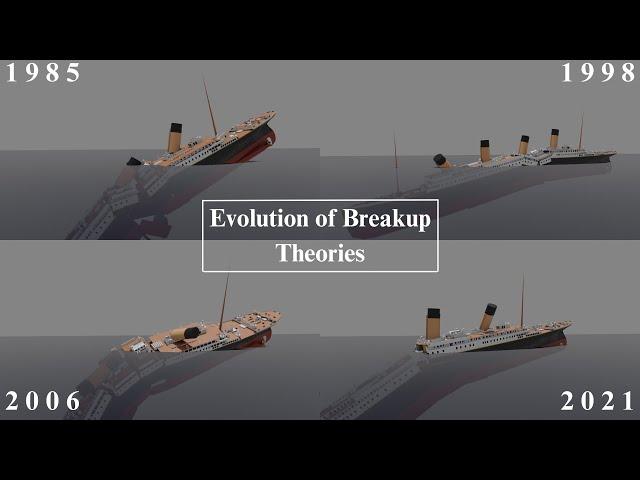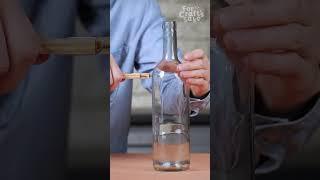Комментарии:

2021
Ответить
The general rule of thumb when trying to model the breakup of Titanic is to understand what the wreck of Titanic looks like today, notably the stern section and where the ship is broken. It's broken into chunks, in multiple locations. 1 inch thick solid steel plated folded back like a taco, or ripped clean through. These are feature that CANNOT be achieved by a 30 knot current. It is my belief that nearly 100% of the damage to the wreck and segmented chucks of steel happened during the break. Why is the starboard side plating of the stern section nearly entirely missing? Do you believe a 30-35 knot current caused that? Or does it make more sense that was torn off in the inherently violent breakup event, where the entire weight of the stern is hinged onto the steel? Which seems more likely? Structural failure at such a large scale is not just one crack runs down the side and the thing breaks cleanly. There are numerous failure points happened simultaneously. The ship is listing forward and to port, so the starboard side plating is under a ton more stress than the portside plating. Recall earlier, I mentioned the missing shell plating on the starboard side of the stern. Are you starting to see the connection? The port list puts a ton of pulling, tension stress on the starboard side, when the plating fails and the weight of the stern hinges, with all the leverage, against that plating it easily rips the plating and frames clean off. The port side plating is largely intact apart from being dislodges on impact with the sea floor. This makes sense. That's a lateral dynamic to the breakup.
Let's explore the debris field. Note the fact that the end of the stern piece and the end of the bow piece don't line up. Why? Because there's a chunk that was in between those two pieces that is not currently attached to any part of the two large sections of the wreck. So where did this 'missing middle' that was right at the point of breakup, go to? Well, it still exists. Not in one piece, but in multiple large chunks. Two double bottom sections, two tower sections, and a chunk of decking and plating right around the galley deck (this will be important later). If the ship broke cleanly, how do you explain these chunks of debris from right under the breakup? Currently don't do that. This CLEARLY is a direct result of the breakup process. This is easily explicable by ditching the common 'single point of expanding failure' model, where the structure fails in one spot and that failure building cleanly from there. Drop that. Evidently there are multiple point of failure. Fractures that may start as a single failure point expand into multiple. Physics analysis show the double keel will fail first, the compression damage as the ship hinges (because the ship at this point has now literally broken its back) the structure hinges on the side shell which is NOT designed to take that load, it's listing as mentioned earlier pulling frames apart. The structure is failing these cracks extend up as the ship hinges more and more weight against decks and side shell easily ripping them apart. The double keel first failure explains the two pieces of double keel in the debris field.
Titanic had was is known as a 'strength' deck. Where two strakes were layered on top of each other. This 'double strake' was at D Deck. What else was at D Deck? The galleys. Recall to the galley decks mentioned earlier. This is the first point in the break where the break reaches resistance. The strength deck is strong enough to buffer the breakup for a little bit, possibly up to 2 seconds. Meanwhile due to shifting leverage after the ship broke its back, the upper works begin to pull themselves apart. A poor designed expansion joint represents a failure point and is seated where the two tower sections meet. This separates the two tower sections from each other but not necessarily from the ship. This failure works down, to the strength deck again. Now the entirety of the entire sterns weight is leveraging against the strength deck. That's too much for the strength deck and it failures. This defines your boundary for the galley deck section. So we know have, by just describing breakup dynamics, defined the double bottom pieces, the galley decks, and the two tower sections. The shifting and twisting as the ship breaks shifts the leverage multiple times, in multiple directions, in succession, rapidly. This defines the after limit of the break, the stern falling back and pulling on the structure defines that spot. The bow section, being negative, trying to sink, pulls against the forward end of the break. Couple this with the fact that there's a skylight that goes all the way down, and an uptake casing that goes all the way down, meaning this is a natural weak spot of the ship anyway, and this is how you get your forwardmost and aftermost ends of the break, defining each boundary of each chunk found, leaving no stone unturned. Once this process is complete, the stern section, left in ruin, settles back. Due to the massive chunks of missing hull now, it floods rapidly and sinks insanely fast.
The position of the chunks in the debris field only define when the pieces, which were already separate, or nearly entirely separate, falls away from the sinking stern. The forward tower is pulled on by the bow and falls away from the ship and lands far away from the stern, the double bottom pieces are flat and plane away, and land far, the rest of the pieces simply rolled off as the stern sank and thus land roughly near the stern section as they entered the water at the same time and in a very similar manner. The stern found itself in basically the condition it was found the moment it slipped beneath the waves. Part of the portside plating and possibly the well deck too, was blown out upon bottom impact. This means that very little damage was done during the fall to the sea floor. The fall would've been relatively peaceful compared to violent sinking earlier and the brutal bottom impact to come. The cause of the spiraling motion of the stern is simply due to the uneven way this stern piece is now loaded.
In my opinion, this explanation is the most thorough and accurate description of the breakup you are likely to find. It accounts for all the physical evidence at the wreck, and doesn't invoke goofy physics or rely on contradictory cherry picked eye witness accounts.

I am very happy I didn't need to see another v-break
Ответить
So someone tell me, am I the only one here who believes the 1997 break up/stern sinking theory?
Ответить
Titanic’s sinking together
Ответить
Park's sank like britannic
Ответить
My favorite theory is james Cameron's 2012 theory.
Ответить
1.25 x sound like Minecraft
Ответить
the song feels nostalgic kind of from my childhood
Ответить
Family your theory is essentialy James Cameron’s depiction just slower and with the forward and aft section fully splitting. The two halve did not split fully until the sea pressure cause the iron to snap. Otherwise it’s a decent depiction of a ship’s physics other than the aft part staying afloat for so long after the split.
Ответить
I like roy mengots theory
Ответить
I like it james cameron teory
Ответить
😂😂😂
Ответить
Yours was the best❤
Ответить
2008 отстой он не разколололся в начале
Ответить
I'm going with your theory
Ответить
Who feels bad for all the Titanics that sank in this vid
👇

my theory is,ship reaches a high enough angle,the ships structure stresses,and the ship starts to bend,the ship breaks,the stern is still connected to the bow by the double hull at the bottom,the stern falls,the bow disconnects,the stern goes up,and the stern floods.
Ответить
Jack Thayer said in his accounts that the TITANIC broke in half. But that was discounted by most sources- they felt it sank in one piece. Even in A NIGHT TO REMEMBER, Walter Lord dismissed it. The wreck proved Jack was right.
Ответить
Your theory is actually pretty smart but u think we’ll never know
Ответить
on the surface of the ocean, the Titanic broke into two parts between the 2 and 3 pipes. After the stern sank, another part broke off. When the stern was already sinking to the bottom, a break occurred already at the 4th pipe. So it's nonsense that the Titanic broke into three parts on the surface of the ocean
Ответить
Imagine ripping one of those funnels like a puff bar...
Ответить
team 1995
Ответить
Jes cameron was not on 1995 it was on 1997
Ответить
Where’s the ultra believable V break theory?! 😜
Ответить
For me, it would be almost impossible for the ship to break into different parts.
My theory is that the Titanic would break between chimneys 2 and 3. After that, chimney 3 would fall into the stress area, where it would collapse.

Tamity NO.2 DAMAR
Ответить
it can’t breakup that easily because of its pressure in titanic movie it was about 25-30 degrees up
Ответить
I wonder what website it is i like to make my titanic theory
Ответить
What’s the song called in the background? It’s so realaxing..
Ответить
well
i have a theory of my own
The engines and boilers are extremely heavy, and they themselves may have been causing alot of stress as the ship tilted upward.
The engines became unstable and began to loosen due to the weak structure (the tilt of the ship may or may not have helped as well). As parts of them slipped more and more, it just caused more stress until the ship couldnt handle it. The pressure on the back became more and more as parts and pieces fell and added more weight to it. Eventually, it began to tear the structure apart. The titanic wanted to bend from the pressure, but the hull was weak and the water pressure in the bow caused it to snap, bend like a straw, and rip itself apart. It broke into 3 (possibly 4) sections, the bow and most of the ship, a small portion with the third funnel and forward tower, and the stern. The bow was still connected to the third funnel section, and the third funnel section was barely still connected to the stern. The bow sank, and on the third funnel section part of the forward tower collapsed, bringing down the third funnel. The third section then flopped over and practically faceplanted into the water, pulling the stern up with it. The pressure of the stern pulling up was too much on the engines, and eventually, part of the starboard engine (the forward cylinder) became completely loose and disconnected from the engine, slamming into the hull and falling out of the ship. The stern is pulled completely upright with a slight port list because the port engine weighs slightly more than the starboard engine now due to the loss of the forward cylinder, and the stern floods quickly. Eventually, the third funnel section disconnected, and the upright stern began to sink straight down into the water.
I've always felt like it's inaccurate how the ship is described as a clean 2 or maybe 3 section break. People always show the break as if it pulled itself apart. It wouldn't be such a clean, straight-down break. Instead the pressure would likely bend and rip the superstructure like a straw, as depicted in my theory.
It may not be entirely accurate, but I think it's more realistic compared to the 1997 theory and the others.

My theroy is a bit like park stephon
1.2nd Funnel Collapse 2:17:53 AM
2.Lights Go Out 2:17:55 AM
3:Ship Splits Near The Third Funnel 2:18:01 AM
4.Funnel 3 Collapse Causing 3rd section Break 2:18:04 AM
5.Third section Break pulls stern to extreme port at 75° 2:18:11 AM
6. Stern Starts to go down And Flips to Different Side 2:19:02 AM
7. Stern starts getting pulled down 2:19:17 AM
8. Titanic Sinks 2:19:58 AM
9. Double Implosion At The Stern 2:20:32 AM

I believe the first one of James Cameron, with the capsize
Ответить
Not the 2012, the 1995
Ответить
Combined with the 2012 capsize
Ответить
You forgot the 2019 roblox titanic theory where the back of the stern sinks by a bit for a second then after a pause the stern rises vertically and sinks in slowly with no dramatic affect like sprays or splashes pretty much and the air pressure causes air to violently spray out of deck and the ship starts spraying water just as the superstructure of the ship sinks underwater
Ответить
Your theory is just so wrong first the stern wouldnt be in that position for so long and there was no port list
Ответить
I THINK UR THEORY CAN BE ACCURATE. BUT IM NOT SURE
Ответить
It’s not possible that the Funnel Stays That Long In The Broken Section In Your Theory And There Is Some Minimal possibility of going to starboard after the breakup,still a good explanation.
Ответить
It’s not possible that the Funnel Stays That Long In The Broken Section In Your Theory And There Is Some Minimal possibility of going to starboard after the breakup,still a good explanation.
Ответить
Lets take a moment for not just how many people died but how many titanics were sunk in the making of this presentation...
Ответить
Nice job. My only question for your personal theory; the funnels were basically made of sheet metal, correct? Of course they had enough weight to crush swimmers, but you think they’d be heavy enough to mangle the deck? I’d think that maybe it would just crumble and bunch up. Of course, not saying that you’re wrong. Just would like to hear more of your POV.
Ответить
Btw just to let you know it’s funnels not towers❤😊
Ответить
Rating Break/Split Theory :
Robert Ballard : 100/10
James Cameron 1995 : 100/10
3 Section Break : 7/10
Park Stephenson : 120/10
Roy Mengot : 70/10
James Cameron 2012 : 110/10
On a sea of glass : 9.5/10
GamePlayerZ : 99.9/10
Tamity : 120/10

If there's no enough weight on the stern so it will not break it that's why the stern is high enough to have a stress in the breaking part
Ответить
People who saw on a sea of glass that the lights came back on
Ответить
I’m sorry, but I don’t see Titanic breaking in 3 or 4 sections, it doesn’t line up with survivor accounts.
Ответить
Song name for the other vid that has these animations?
Ответить
Decided to make a comment which answers a lot of questions I get.
Q: Why don't we just go off what survivors say?
A: That's what some of these theories do. Also, basically every survivor contradicted each other due to the darkness and position at which they are located when the ship broke. This makes it difficult to account for some of them.
Q: What are towers? You mean funnels?
A: The "Towers," which are mentioned frequently in the video are chunks of superstructure which are called the "forward and aft" towers. The forward tower is the chunk located where the third funnel is. The aft is directly behind it, although slightly smaller.
Q: Why did you not include the V-Break?
A: I simply just don't like to talk or animate much about it for no reason at all really.
Q: Why do people care so much about this stupid topic? Why does it matter?
A: It is simply a tragedy that we the community enjoy to research and learn about. It's an interesting topic in our opinions. It's like how people obsess over video games or books.
Q: Your theory is wrong because you have the engine fall out and they are still on the wreck today!
A: I should've used my words correctly while editing, but only the forward cylinders are not in the stern. They are scattered in the debris field. The rest of the engines are still in the stern.
Q: They are just the same theory!
A: No they are not. In fact, they are all quite different. I mean, look at the first theory, and then look at mine (or basically any other theory) and it will look different.
If you need to ask any questions, ask them here.



























